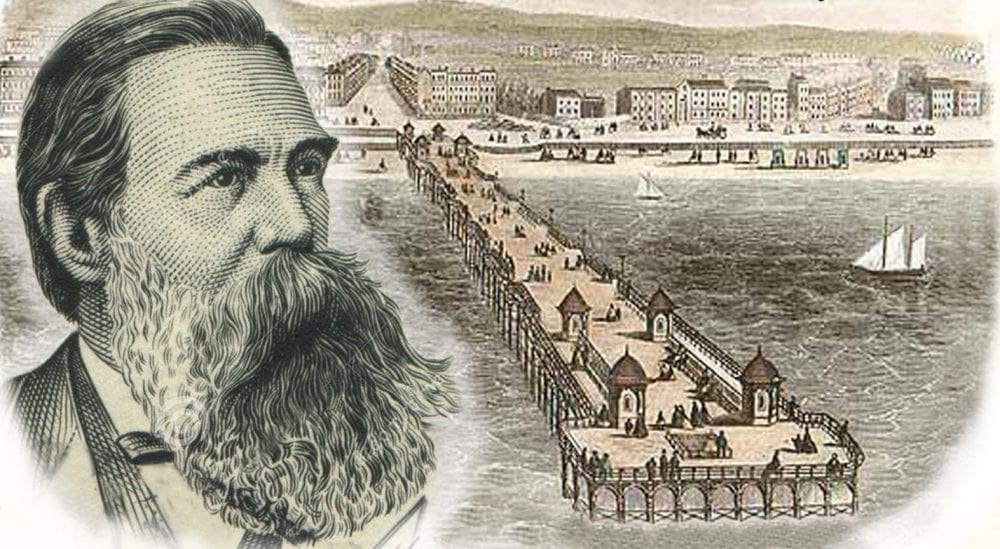How Eastbourne Got Its 1976 Engels Plaque
This story starts in 1975, before the 1989 fall of the Berlin wall (of course), at the London Embassy for the German Democratic Republic (East Germany). The GDR were surprised at how little Karl Marx and Friedrich Engels were commemorated in England. They were keen for this to change and so the embassy mapped all the areas where Engels and Marx lived and worked; and of course, this included Eastbourne.
Enter the National Museum of Labour History, which at that time was based in Limehouse Town Hall, Commercial Road, Tower Hamlets. The origins of this museum derived from the Labour History Archive (held at Labour headquarters), the Trade Unions, and Labour and Co-operative History Society. The museum was opened on 19th May 1975 by Harold Wilson and became the home of the Labour History Archive. The Museum was closed in 1986 but then reopened in Manchester in May 1990 – known initially as both the National Museum of Labour History and the Pump House People’s History Museum. The museum is now known as the People’s History Museum.
The National Museum of Labour History developed close associations with the Soviet, the GDR and the Cuban embassies. It was in this first year that the plan for a plaque to Engels in Eastbourne was first seeded. Terry McCarthy, the curator of the Labour and Co-operative History Society and founder member and Director of the National Museum of Labour History tells us,
“I had the privilege of teaching British Labour history to young people whose families worked in the Soviet and GDR embassies as well as the frequent visits from delegations from socialist countries; this included Cubans. We had regular talks and lectures on Sundays. It was at one of these events that the issue of plaques came up and Eastbourne was mentioned. Hymie Fagan – a historian, journalist, and Communist Party national election agent – who was a close friend of the Museum, volunteered his services. After consultation, it was decided the GDR Charge D’Affaire should unveil the plaque. We had discussions with the owner of the hotel and when given approval we then notified Eastbourne Trades Council and the local Communist and Labour parties. So, the decision to unveil a plaque was international. Both Henry Fry, myself and Hymie’ were members of the Communist Party”.
The commemorative plaque project then took off locally. Eastbourne Trades Council, Eastbourne Labour Party and the Eastbourne Mayor’s Office all worked together on the preparations. Eastbourne Trades Council paid for the plaque and its installation. The Mayor’s Office were extremely helpful in arranging for the police to be present. The Mayor at the time was Clifford Scott was present for the unveiling of the plaque. Len Caine, the Eastbourne Labour Party’s Parliament candidate at the time was also present. Caine was, for many years, a pivotal figure in the Trade Union Movement in Eastbourne. He was a Labour Councillor for nearly 20 years having first been election in 1963. He fought both the 1974 and 1979 general elections.
And whilst the local preparations were going on Terry, Hymie and Henry were working on invitations to the GDR and Cuban embassies. Senior figures invited were Heinz Birch, the GDR Charge D’Affaires, (who unveiled the plaque) and Senor Lionel Soto, Ambassador at the Cuban Embassy. Lionel Soto Prieto (1927-2008) was a Cuban revolutionary, historian, diplomat and professor. He was imprisoned during the dictatorship of Fulgencio Batista. Released in 1959, he held positions within the Communist Party of Cuba and the Cuban government, including representing Cuba as ambassador to the Soviet Union and Great Britain.
There were those who were not too pleased with the involvement of the GDR and Cuban embassies in the unveiling of the plaque. This was during the Cold War period so you can imagine. I will leave this account here. The story of the unveiling of the plaque was covered by the Eastbourne Gazette which you will find on our website. I will leave you to look this up. It is left to be said though that the plaque did not stay in situ for long. The National Front were present at the unveiling in protest and were intent on damaging the plaque. In fact the plaque need to be taken down for the night because of this threat. This did not deter the intent however and within 6 months the plaque was taken down permanently. The graffitied plaque is now in the archives of the Manchester People’s History Museum.
There is unfinished business. The story ought not to end here. To support the campaign for the reinstalment of the plaque please find details here:-
https://www.facebook.com/EBEngels/
Thank you to all those involved in the instalment of the 1976 plaque. And thank you particularly to Terry McCarthy for providing information and lending his support that has invigorated our campaign.
Carol Mills


Thank you! Its wonderful to read about all the effort and work that has gone into bringing Engels to the awareness of the citizens of Eastbourne. I hope we can do more to bring his work and contribution to progress to everyone’s attention.